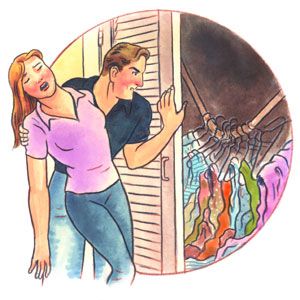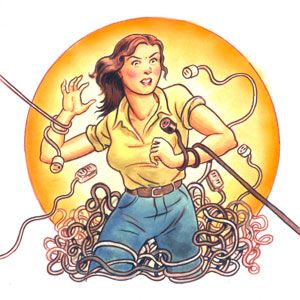As a homeowner, you take pride in your property and want to maintain it well. However, even with the best intentions, you might unknowingly engage in habits that can damage your home over time. From overloading closet rods to misusing drain cleaners, these seemingly harmless actions can lead to costly repairs and compromised safety. In this guide, we’ll explore common homeowner mistakes and provide practical solutions to help you better care for your home.
Common Home Mistakes That Cause Damage
Let’s start with some common mistakes that can harm your home’s structural integrity and how to avoid them.
Overloading Closet Rods and Shelves
Cramming too many clothes onto closet rods might seem like a space-saving solution, but it can lead to significant damage over time. The excessive weight can strain mounting hardware, especially if it’s installed with undersized anchors, potentially damaging your drywall.
To prevent this, use steel rods and metal supports for your closets. Ensure the rod’s length is just 1/4 inch less than the span between supports for maximum contact. For long rods, install additional brackets every 48 inches. When possible, secure hardware to wall studs. If that’s not an option, attach it to a 1-by-4 board that spans studs on both sides of the closet.

Slamming Doors
Repeatedly slamming doors, especially heavy entry doors, can cause more damage than you might realize. The force and impact can push the door jamb out of alignment over time. This misalignment can eventually force the door from its opening, causing separation between the trim and jamb. This gap not only looks unsightly but also allows moisture and cold air to infiltrate your home.
To address this issue, replace existing hinges with self-closing versions. These can be adjusted so that the door closes softly without slamming. For heavy wood doors, replace all three hinges. Lightweight steel doors may only need one or two upgrades.
Neglecting Gutter Maintenance
Gutters play a crucial role in protecting your home’s foundation, yet they’re often overlooked in home maintenance routines. When gutters become clogged with leaves, pine needles, and branches, water can’t flow properly. Instead, it spills over the sides, dumping along your foundation where it can seep into tiny cracks and crevices, potentially causing significant damage.
To prevent this, clean your gutters before spring rains arrive. While you’re at it, check that winter snow and ice haven’t pulled the gutters away from the fascia. After cleaning, consider installing gutter guards to help reduce future buildup and make your next cleaning session easier.
Plumbing and Electrical Pitfalls To Avoid
Misusing your home’s plumbing and electrical systems can lead to serious problems. Here are some common mistakes to avoid.
Flushing Non-Flushable Items
The rise of “flushable” wipes has led to numerous plumbing issues in homes and municipal systems alike. Despite their name, these wipes don’t break down like toilet paper. Once flushed, they can congeal with grease and other materials, causing stubborn clogs that are difficult to remove.
To avoid this, place a lined trash bin in your bathroom for safer disposal of these wipes. Better yet, stick to biodegradable toilet paper. Never flush feminine products or paper towels.
Misusing Extension Cords
Extension cords are meant to be temporary solutions, not permanent fixtures in your home. Overreliance on extension cords can pose serious electrocution and fire risks.
Instead of relying on extension cords, consider upgrading to grounded receptacles where you need them most. When you do use extension cords, choose the right gauge for the job: 16-gauge for small appliances drawing up to 13 amps, 14-gauge for large power tools using up to 15 amps, and 12-gauge for items needing 20 amps, such as compressors.
Overloading Electrical Circuits
Repeatedly resetting tripping breakers might seem like a quick fix, but it’s a dangerous habit. Each time you reset a breaker, you’re potentially wearing out its safety mechanism, which could increase the risk of an electrical fire.
To address this, try to reduce the load on problematic circuits. Master electrician Scott Caron notes, “Dehumidifiers, countertop convection ovens and microwaves, and air conditioners are often overload culprits.” If a breaker has tripped five times, have an electrician replace it. For a long-term solution, consider upgrading the entire circuit to handle a higher load.

Outdoor Maintenance Errors
Your home’s exterior needs just as much care as its interior. Here are some common outdoor maintenance mistakes to look out for.
Leaving Outdoor Rugs in Place Year-Round
Outdoor rugs add comfort and style to your patio or deck, but leaving them in place year-round can cause problems. Rugs with rubber or vinyl backings can trap moisture, leading to mold and mildew growth. This can result in spongy deck planks that eventually crack or break and it creates an inviting environment for pests.
To prevent this, choose open-weave rugs that allow rainwater to evaporate and air to circulate. When cleaning your outdoor rugs, rinse them gently with a hose and hang them over a railing until they’re completely dry.
Improper Storing
While the space under a porch or deck might seem like ideal storage, overfilling this area can cause problems. Packing in furniture, ladders, grills, and other items can hinder air circulation, trapping moisture and heat that can warp your deck boards.
To use this space safely, maintain at least 12 inches of open space beneath the joists to allow for proper air circulation. Also, avoid storing firewood in this area, as it can attract termites.
Walking on the Roof
While you should keep an eye on your roof’s condition, walking on it can do more harm than good. Not only is it dangerous for you, but it can also damage your shingles and potentially void your roof’s warranty.
Instead of walking on the roof, inspect it from the ground using binoculars. For gutter cleaning, use a ladder with a stabilizer bar to protect the gutters’ thin-gauge metal.
Indoor Mishaps at Home
Even inside your home, certain habits can lead to damage over time. Here are some indoor care mistakes to avoid.
Building Large Fires
While a roaring fire might seem cozy, oversized fires in your fireplace can cause serious damage. Chimney expert Mark Schaub warns, “Burning wrapping paper or pizza boxes can cause a fire to jump from 300°F to 1,700°F.” These extreme temperatures can damage your chimney lining, whether it’s metal or terra-cotta.
Keep your fires small enough to see the flame tips. Schaub recommends starting fires with a log across the back of the grate, another in front, and a fire starter brick in the middle. Light the brick, and once it catches, rest a third piece of wood diagonally across the first two.
Misusing Drain Cleaners
While drain cleaners can be a quick fix for clogs, overuse can cause significant problems, especially if you have a septic system. These harsh chemicals can kill the essential bacteria that break down waste in your septic tank.
As a first line of defense against clogs, try flushing the drain with boiling water. For stubborn clogs, mechanical cleaning with a closet auger snake is less damaging than chemical cleaners. If you must use chemical cleaners, do so sparingly.
Structural and Safety Concerns Around the Home
Some homeowner habits can compromise your home’s structural integrity and safety. Here are a few to be aware of.
Stressing Roof Trusses With Excess Weight
Storing heavy materials in your attic or garage rafters can overload your roof trusses. Even a traditionally framed roof, which is stronger than trusses, can fail if overloaded above the joists.
Instead, store heavy materials at ground level. For items that you must store overhead, use the dead space in corners by installing triangle shelves. If you’re concerned about compromised trusses, consult a structural engineer.
Ignoring Loose Electrical Outlets
Electrical outlets can loosen over time, especially those that see frequent use. This wiggle can cause wires to pull out, increasing the risk of arcing and potentially fire.
To fix this, turn off the power to the outlet at the electrical panel. Remove the outlet cover, tighten any loose wires, and use plastic shims to stabilize the receptacle before replacing the cover.
Using Incorrect Wall Anchors
The wall anchors provided with many hanging kits are often inadequate, especially for drywall. These expanding plugs are designed for dense masonry and plaster walls, not the more common drywall found in most homes.
For drywall, use anchors specifically designed to grab the thin wallboard and hold a screw. Choose a threaded anchor and a fastener that’s twice as long as the material is thick. Toggle bolts are another good option for heavier items.
Chemical and Cleaning Mistakes
Certain cleaning habits and chemical uses can inadvertently damage your home. Keep these in mind.
Overusing Bleach Tablets in Toilet Tanks
While bleach tablets in your toilet tank can keep your bowl clean, they can also cause premature damage to the rubber and plastic components inside the tank, including the crucial flapper valve.
Instead, clean your toilet the old-fashioned way with a brush and occasional cleaner. If you prefer an automatic option, use a product that dispenses cleaner into the bowl with each flush rather than one that sits in the tank.
Scrubbing Grout With Vinegar
Vinegar is touted as a natural cleaner, but that doesn’t mean it’s suitable for all surfaces. Traditional white grout is a sand-and-cement mix, and the acid in vinegar can turn it yellow and crumbly over time.
For grout cleaning, opt for an alkaline hard-surface cleaner or an oxygen-bleach-based product. Always rinse well after cleaning, and use a utility vacuum to lift dirt out of the grout lines.
Painting Over Rust Without Preparation
Painting over rusty metal is only a temporary solution. The rust will prevent the new paint from adhering properly, leading to flaking and peeling.
To properly paint rusty metal, first remove surface corrosion and peeling paint with a scraper. Feather paint edges with 100-grit sandpaper. Treat rusty spots with a rust primer before coating the entire surface with direct-to-metal (DTM) paint, a special acrylic formulation designed for metal surfaces.

